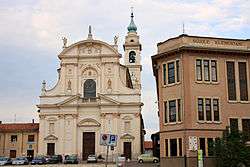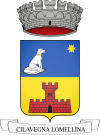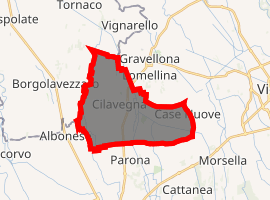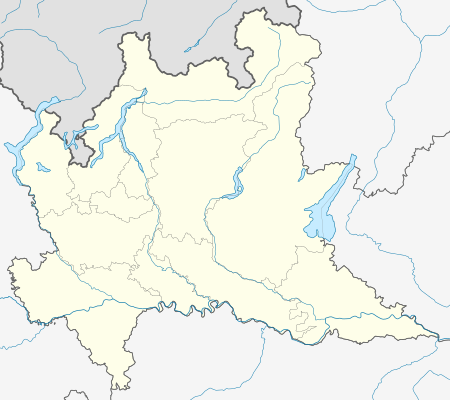Cilavegna
'Cilavegna' ( AFI : / ʧilaˈveɲɲa / ; Western Lombard: Silavégna) is a comune (municipality) in the Province of Pavia in the Italian region Lombardy, at about 45 km southwest of Milan and about 35 km northwest of Pavia. It has 5440 inhabitants.
Cilavegna Silavégna | |
|---|---|
| Comune di Cilavegna | |
 | |
 Coat of arms | |
Location of Cilavegna 
| |
 Cilavegna Location of Cilavegna in Italy  Cilavegna Cilavegna (Lombardy) | |
| Coordinates: 45°19′N 8°45′E | |
| Country | Italy |
| Region | Lombardy |
| Province | Pavia (PV) |
| Government | |
| • Mayor | Giovanna Falzone (Lista Civica) |
| Area | |
| • Total | 18.0 km2 (6.9 sq mi) |
| Elevation | 115 m (377 ft) |
| Population (31 agosto 2019)[2] | |
| • Total | 5,548 |
| • Density | 310/km2 (800/sq mi) |
| Demonym(s) | Cilavegnesi |
| Time zone | UTC+1 (CET) |
| • Summer (DST) | UTC+2 (CEST) |
| Postal code | 27024 |
| Dialing code | 0381 |
| Patron saint | Saints Peter and Paul |
| Saint day | 29 july |
| Website | Official website |
The town has an ancient agricultural tradition since in Roman times it was used to growing vines; nowadays pink asparagus is the most important farm. In the first decade of the 20th century is dated the birth of an industrial center outside the inhabited center. The first detailed page of history of Cilavegna is the concession of Berengario del Friuli, a no-dated document (certainly before 25 December 915).
Cilavegna is mentioned in the psychological novel Ipotesi di cacciatore by Gregorio Ponci, in which the family of the main character, Viscardo, has its origins since the XVIII century in Cilavegna, also mentioned with the oldest denominations of Cilavinnis , Cellavegna , Celavegno .
Toponymy
One hypothesis sees Cilavegna as a compound name: the first part is the word "cell", which refers to the meaning of "deposit of the military rations", that is a typical Roman settlement along the streets of the Empire; the second term, "vegna", indicates the ancient cultivation prevalent in this place: vine.
This hypothesis can be confirmed thanks to a concession made by King Berengario I, presumably dated between the years 911 and 915, which bears the name Cilavinnis, very close to the Latin vinea or vinum.
Then the toponym has became "Cilavegna": it consists in the progressive addition of the "g" in the last syllable. That's change is crystal clear reading the documents in which Cilavegna was named; in 1164 it was " Celavegna ”, then Cellavegna (1181, 1220), 1250), Cillavegna in 1181 and Celavegno in 1219.
History
The area of Cilavegna was inhabited since as early as the Mesolithic age. During the Roman domination, a series of roads were built here to connect the military posts of the area, one of which was that of cella ad vineas, whence the modern name.[3]
After the Lombard conquest of northern and central Italy, it was the seat of a gastald (judge). After the Lombards were overrun by Charlemagne, it became a possession of the counts of Lomello. The local castle was likely built in this period (10th century), as a defence against the Magyar raids. In the following centuries it was held by several feudal families, including the Taverna (1636-1798).
Geography
The territory of Cilavegna is included in the Pianura Padana. The municipality is located next to the border with Piedmont (province of Novara) and it is surrounded by the area of Alta Lomellina, a territory in the south-western area of Lombardia between Sesia (to the west ), the Po (south-west), the Ticino (to the east) and the Basso Novarese (to the north).
The area is mainly flat with some sandy areas in relief and is characterized by a single large wooded area (the "Bosco Oliva") which is protected by the municipal administration. The economy, mainly agricultural, has changed the local environment; in particular, the landscape is characterized by a dense network of canals and ditches, while the vegetation is enriched with fields of corn, rice fields, poplars and chestnut woods. The hydrographic mapping highlights some fountains, useful for feeding the waterways.
Cilavegna is classified as a very low seismic risk area.
Climate
The climate is typical of the municipalities of upper Lomellina: over the years the winters have become less cold, but temperatures still remain around 0 °C; the warmer months, on the other hand, are characterized by ever higher temperatures. Furthermore, due to global warming, winter snowfalls are rare and often limited to the colder months, while in summer the heat is common.
Cityscape
Demographics
Censuses
| Year | Population |
|---|---|
| 1861 | 3643 |
| 1871 | 3892 |
| 1881 | 4130 |
| 1901 | 4786 |
| 1911 | 4833 |
| 1921 | 4456 |
| 1931 | 4102 |
| 1936 | 4125 |
| 1951 | 4165 |
| 1961 | 4533 |
| 1971 | 4366 |
| 1981 | 4211 |
| 1991 | 4416 |
| 2001 | 4976 |
| 2011 | 5656 |
Ethnic groups
According to ISTAT, there are 296 residents of foreign origin in Cilavegna as of December 31, 2018, or 5.4% of the total. The largest foreign communities are from Romania (1.26%), Albania (0.68%) and Egypt (0.49%).
Economy
Culture
Education
Transport
International relations
Cilavegna has only a sister city.
| City | Country | Date |
|---|---|---|
| Condat-sur-Vienne | France | 1956 |
Notable people
- Mario Pavesi - business man
- Pietro Conti da Cilavegna - inventor
- Gian Battista pirolini - politician
- Annibale Omodei - heart surgeon and scientific writer
- Alberto Calvi da Cilavegna - bishop
See also
References
- "Superficie di Comuni Province e Regioni italiane al 9 ottobre 2011". Istat. Retrieved 16 March 2019.
- All demographics and other statistics: Italian statistical institute Istat.
- Bergamo, Romano (1995). Storia dei comuni, frazioni e parrocchie della Lomellina. Pavia: Selecta Editrice. p. 263. ISBN 8873323170.